Self-portraits and
Self-presentation in the Work of George Gascoigne
Gillian Austen
University
of Bristol
g.austen@bristol.ac.uk
Gillian Austen. "Self-portraits and Self-presentation in the Work of George Gascoigne ". Early Modern Literary Studies 14.1/Special Issue 18 (May, 2008) 2.1-34<URL: http://purl.oclc.org/emls/14-1/article1.htm>.
1.
George Gascoigne, the most
inventive and influential poet of his generation, has always resisted easy classification.
He wrote in many genres but rarely wrote in the same style twice: a successful
and witty poet who influenced writers including Spenser,
Sidney
and Shakespeare,
his modern reputation has failed to recognise his significance. Gascoigne’s
many innovations have contributed to the difficulty in situating his work in
the canon. Known as an experimenter, he is mostly remembered today for just a
small number of his works: A Discourse of
the Adventures of Master FJ (one of the earliest prose fictions in
English); the Supposes (one of the
earliest translations of Ariosto and a source for the Taming of the Shrew); “Gascoignes wodmanship” (perhaps the best of
the early Elizabethan short poems, and frequently anthologised); and “Certayne
Notes of Instruction”, the first essay on English versification. Moralist,
satirist, dramatist and sonneteer, he was also a courtly poet and deviser of
courtly entertainments. One aspect of his work which is especially unusual is
his use of illustrations, all by his own hand. This paper attempts to explain
the significance of those images and engage with the purpose they served.
2.
The ten images by Gascoigne
which survive are all forms of self-portrait. Gascoigne was not unique in using
author portraits (1).
For example, Thomas Becon included a portrait on the title page (verso)
of his Worckes which shows him
sitting at a desk with his books and a pen, knife and ink, in a furred
scholar’s gown and cap (2). John Skelton had at least two styles of
portrait: both a scholarly Skelton, seated at his desk, and a courtly standing
figure with thistle and laurel marked “Skelton Poëta”. For Skelton, the two
styles could even co-exist in one volume, as in the Chapelet of Laurell (R.Faukes, 1523) (3). Lisa Jardine’s study of the great
humanist scholar Erasmus includes his author portraits and shows how he planned
and commissioned them in order to shape his reputation for posterity (4). And Thomas
Whythorne included an author portrait in his Songs for three, fower and five voyces (1571) which may have
provided a model for Gascoigne’s self-portrait in the Steele Glas. (Gascoigne’s interest in music suggests that he could
have been aware of Whythorne’s book.) But Gascoigne is unique in creating a
range of self-portraits in both print and manuscript. As well as eight extant
self-portraits there are two emblematic devices by Gascoigne which are visual
self-presentations. Although they do not
include his image they can also be considered as self-portraits on a more coded and symbolic
level.
3.
A
collection of ten self-portraits might
suggest an overt – or at least an easily detectable – quest for fame and
celebrity, or a keen eye to posterity, as with Erasmus. But three of
Gascoigne’s self-portraits were included, unattributed, in a book published
anonymously; one was published, also unattributed, in someone else’s book; and
five were in private manuscripts with a very small (and exclusive) circulation
and with no expectation that they would ever be published more widely. Only one
of Gascoigne’s self-portraits appeared in print under his own name and can
therefore be said to have been intended for wide dissemination. Nonetheless, as
I hope to demonstrate, these images are a crucial part of Gascoigne’s
preoccupation with self-presentation as a means to manoeuvre within the system
of patronage.
I
4.
The received view of
Gascoigne’s career originates with the Posies
(1575), the revised edition of his A
Hundreth Sundrie Flowres (1572/3), when Gascoigne tried to overcome his
past failures and poor personal reputation by presenting himself as a Reformed
Prodigal in his prefatory material (5). Although this new self-presentation did not
persuade his contemporaries, his twentieth-century biographer, Charles T.
Prouty, found it so convincing that he miscast Gascoigne as a “repentant
sinner” who wrote only moral works after a personal reformation in 1575 (6). As I have argued
elsewhere, the Reformed Prodigal became the predominant model for the modern
understanding of Gascoigne’s career because it was his favoured
self-presentation in print under his own name, used in all of his moralistic
works (7). But he
continued to pursue more courtly opportunities when they arose, so that from
1575 he was cultivating a moralistic portfolio of titles alongside his courtly
performances, manuscript works and anonymous publications. Nonetheless,
Gascoigne’s courtly activities were as serious as the moralistic titles, and
they served a similar purpose, which was Gascoigne’s quest for patronage and
preferment.
5.
Gascoigne’s penitent
self-presentation was an attempt to overcome his poor personal reputation and
persuade some of his potential and actual patrons that he had reformed his
profligate ways. He first presented this new moralistic persona in the Posies in January/February 1575 and
quickly followed it with another moralistic title, his Prodigal Son play The Glasse of Government, in April. But
at about this time the opportunity arose to be involved in the greatest courtly
entertainments of Elizabeth’s reign: the Earl of
Leicester’s extravaganza at Kenilworth in July
that year, during the Summer Progress.
6.
Leicester’s plans would have
been known for months in advance around the court and beyond, among the
booksellers and writers in London: the
publishing scene for contemporary literature was in its infancy but the
booksellers around St. Paul’s
churchyard were thriving. One of them,
Christopher Barker, published in June a pair of books on the most
courtly sports of all, hunting and falconry, for which Elizabeth
had a well known passion.
Gascoigne’s The Noble Arte of Venerie,
a translation of the latest French hunting manual, was commissioned by Barker
as part of a combined project with George Turberville’s Booke of Hauking (8). Gascoigne’s volume was published anonymously
and after his death it became attributed to Turberville by association with his
book, which bore its author’s name. The Noble
Arte was correctly attributed to Gascoigne by Jean Robertson in her 1942
article (9).
Although Professor Prouty had not included it in his biography of
Gascoigne earlier that year he went on to publish an article, co-written with
his wife Ruth, which sought to fit the Noble
Arte into the model of the Reformed Prodigal (10). They conceded that it did not fit the model,
but the inconsistency was never properly resolved.
7.
The reason for Gascoigne’s
anonymity in this volume – as the Proutys speculated - is that the Noble Arte is
a courtly, fashionable work which would not suit Gascoigne’s moralistic
persona. But his responsibility for the volume is unlikely to have been a well
kept secret. Even without his name on it, a number of readers would have known
the identity of the book’s translator, even though they would be restricted to
those readers in courtly circles and within whispering distance of the
St Paul’s booksellers.
8.
The French book of hunting
which Gascoigne translated was Jacques du Fouilloux’s La Vénérie, which had been revised and updated by Galliot du Pré in
1573, when he incorporated portions of Gaston de Foix’s La Chasse into the new edition (11). The Proutys identified this edition as
Gascoigne’s source and show that he made further additions to the text. Either
Barker or Gascoigne designated it the “noble art” and thus signalled its target
readership. Like Du Pré, Barker augmented his source with new woodcuts, but he
went even further than his French counterpart by commissioning the companion
volume on hawking. Barker’s project may have been prompted by rumours of the
Earl of Leicester’s planned entertainments at Kenilworth Castle: it would have
been well known that the Queen would spend much of her time there hunting and
this would have been one of the reasons that the Earl of Leicester had spent
large amounts on enlarging the Chase and the hunting grounds at Kenilworth. But
even if Barker commissioned the two books before hearing about Leicester’s
planned entertainments, the woodcuts of
Elizabeth
enjoying both noble sports – whether proposed by Barker or Gascoigne – would
have greatly enhanced the appeal of this volume for its target readership.
Indeed, Stephen Hamrick has recently situated these woodcuts in context of the
emerging cult of Elizabeth,
suggesting that they may have had even greater significance (12).
9.
Gascoigne suspended the
moralistic persona he had just created in the prefatory material to the Posies in order to pursue this
opportunity and his courtly ambitions. It seems clear that in translating the Noble Arte Gascoigne was presenting
himself to Elizabeth
in particular, but also to Leicester and other nobles, as an expert huntsman, a
“woodman” in contemporary terminology. Two years previously, Gascoigne had used
hunting as his founding conceit (in his terms, the “fine invention”) (13) when he wrote
“Gascoignes wodmanship”, a wry and self-deprecating poem written for
Lord Grey of Wilton
(14). In the
“Wodmanship” he had lamented the many false starts in his career by analogy
with his poor woodmanship – which in light of the expertise he displays in the Noble Arte was a highly ironic pose. It
would simply not be possible to acquire, in just two years, the level of
expertise he displays here (15). Although it was
published anonymously, Barker dedicated the Noble
Arte to Lord Clinton, Master of the Queen’s Hounds. A beautiful and lavishly
illustrated book, it is also a very practical manual: it includes a detailed
account of various maladies that could affect hounds and “receipts” for
treating them (p.219/sig.O6) and it concludes with “the measures of blowing” set down in musical notation (p.
249/sig.Q5).
10.
As published in June 1575, the Noble
Arte includes woodcuts from at least four different sources: there is a
group from the French original; another group in the cruder style of the Otter (sig.
2A); some in the style of the Fox (sig. N3); and three, more accomplished than
those from the French, which feature
Elizabeth
and are new to the English translation. The three new woodcuts which feature
scenes with
Elizabeth
hunting show an “assembly”, where the hunt gathers for refreshment; the report
of a huntsman; and the “breaking up” of the deer. The title page features a
fine etching, which forms a complementary pair with the one on the title page
of the Booke of Faulconrie. One
further piece of evidence that the two translations were companion volumes is
the presence in Turberville’s book of one woodcut of the Queen hawking which is
clearly by the same hand as the three in the Noble Arte (16). The illustrations were an important part of
Christopher Barker’s project and there is evidence that Gascoigne himself
executed the drawings for the woodcuts. The translator of the Noble Arte (conclusively identified as
Gascoigne by Jean Roberston) claims that the printer “hath disbursed great
summes for the Copies, translations, pictures and impressions”(sig. A2v).
Furthermore, in the text, the translator makes the specific claim that he has
executed two of these drawings himself: But for the better declaration and lively expressing of
all these things, I have here set in portrayture as well an assembly, as also
the presenting of a report made by a huntsman to a Prince upon sight of Slot,
view, entrie, portes, abatures, fewmishings, and other such tokens (sig. F7v).
As a translator, too, Gascoigne
signals his departures from his source; for example, he notes that he has
substituted his own version of the English terms of venery for the French of
the original (sig. P5v). But this notice also advertises another of his skills,
so that in the Noble Arte he was able
to present himself as an expert woodman and an accomplished writer, translator
and draughtsman. The commission suited Gascoigne’s agenda very well, since it
was an ideal opportunity to make a good impression in the highest courtly
circles.
11.
All three woodcuts can be seen as celebrating the Queen’s
"woodmanship" (her skill in hunting) and almost certainly show Gascoigne fulfilling the crucial role of
huntsman. (Gascoigne’s likeness may be established by looking at the
self-portrait in the Steele Glas and
the one in the frontispiece to the Hemetes manuscript, both of which are explicitly presented as images of Gascoigne.) The
first, the “assembly” woodcut (sig. F5v), shows
Elizabeth
seated amongst courtiers and
attendants while food and drink are served (see Figure 1). It is a far more
elaborate scene than its French equivalent (17). The huntsman kneels before the seated queen
to accept his orders for the day’s sport. In the next woodcut, the “reporte of
a Huntesman” (sig. F8) shows the same huntsman offering her the deer’s
“fewmishings” or “fewmets” (droppings) for inspection (see Figure 2); and the
“breaking up of the Deare” (sig. I3) shows him kneeling before
Elizabeth
and offering her a knife (see
Figure 3). Each represents a critical moment in the hunt: the “assembly”, with
its social ritual and lavish feasting, illustrates its courtliness; while the
next two illustrate highly technical moments in which Elizabeth demonstrates her own mastery of the art of venery.
The inspection of the fewmets is a crucial moment, when the Queen assesses from
the hart’s droppings its size and vigour, and decides which hart to pursue; and
the “breaking up” of the deer shows her about to make the first cuts on the
fallen animal. These self-portraits, then, both illustrate Gascoigne’s own
desired preferment and create a sustained compliment to
Elizabeth, showing her demonstrating her
highly accomplished mastery of the art of venery.
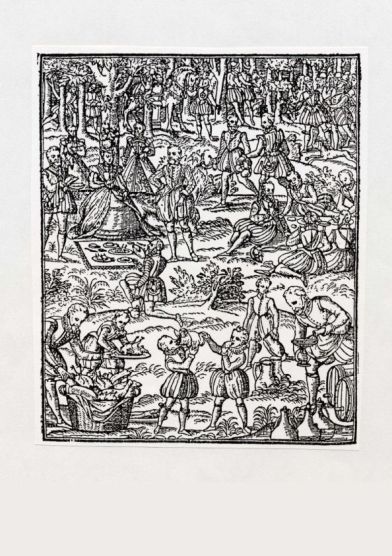
Figure 1. “Of the place where and howe an assembly should be made, in the presence of a Prince, or some honorable person”, in The Noble Arte of Venerie or Hunting (1575); from the Clarendon Press reprint, Oxford, 1908. By permission of the British Library, 799.2*1949*, p. 90/sig.f5v.
12.
Gascoigne was certainly a skilled enough draughtsman to execute the
drawings for these woodcuts, as is witnessed by the Hemetes frontispiece, which he prepared towards the end of this
year (see Figure 5). The main challenge with such a complex composition as the
“assembly” woodcut would be the organisation of the perspective, which is rather
like a tapestry. Gascoigne’s technical ability is obvious from the number of
perspectival devices he employs in the Hemetes
frontispiece: the tiled floor; the doorway in the background revealing
cloisters receding into the distance; the doorway on the right suggesting
further depths. It is a confident scheme, making full use of its pictorial
space, just as the “assembly” and other hunting woodcuts do. Evidently by an
untrained hand, the technical flaws do not detract from this confidence. Minute
detail is evident in all these illustrations: bearing in mind their small size,
and that the drawings for the woodcuts would have been done in reverse to be
transferred to a block, the “assembly” picture is sufficiently well-observed to
show the garters on the knees of the two courtiers nearest to the Queen and the
Tudor rose on the tunics of the attendants far in the background.
13. The second new illustration depicts a highly technical moment, the
next important stage in the day’s events. The “reporte of a Huntesman upon the
sight of an Hart, in pride of greace” shows the queen viewing the deer’s
“fewmets”, from which she could, as an experienced woodman, deduce its
condition. It is only here, in his descriptions of the royal hunt, that
Gascoigne displays any diffidence about his knowledge of the sport: “... I have
set it downe in suche termes as I can, desiring all Masters of Venerie and olde
huntesmen, to beare with my boldnesse in uttering of my simple knowledge” (sig.
F7). In this second new woodcut, the queen stands on a railed wooden platform
with three female attendants and three male courtiers, with the huntsman
kneeling before her displaying the fewmets on leaves, as described in the text.
Elizabeth would then choose which of the deer she wished to hunt, and the
successful huntsman would return to his “blemishes” (the “markes which are left
to knowe where a Deare hath gone in or out ... little bowes plashed or broken,
so that they hang downward”, sig. Gv). The queen is depicted as holding a small
branch, which could perhaps have been one of these “blemishes”, although most
would have been left in situ to
indicate the direction the hart had taken.
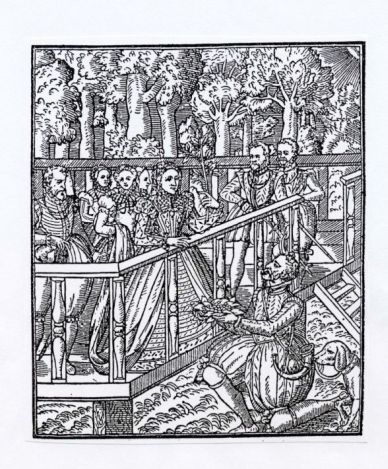
Figure 2. “The report of a Huntesman upon the sight of an Hart, in pride of greace”, in The Noble Arte of Venerie or Hunting (1575); from the Clarendon Press reprint, Oxford, 1908. By permission of the British Library, 799.2*1949*, p.95/sig.f8.
14.
The
third new woodcut, the “breaking up of the Deare”, shows the successful outcome
of the day’s hunting: the queen has dismounted from her horse and the huntsman
kneels beside the deer offering her a knife, with which she would make the
first cut. This is accompanied by a prose substitution by Gascoigne entitled
“An advertisement by the Translator of the Englishe manner, in breaking up of
the Deare” (sigs. I2v-I4). It includes mention of forfeits for poor
woodmanship, if one could not cut out the shoulder cleanly:If afterwardes he touch the shoulder or any part of the legge,
with any other thing than his knyfe, untill he have taken it out, it is a
forfayture, and he is thought to be no handsome woodman. (sigs. I3v-I4)
This
is a reminder of the importance of the huntsman’s skill, the “art” of venery. This
third illustration may have been a very late addition in the production schedule since
it is not mentioned in the translator’s letter. But, crucially, as with the
“report of a Huntesman”, it shows
Elizabeth
poised to demonstrate her own “handsome” woodmanship.
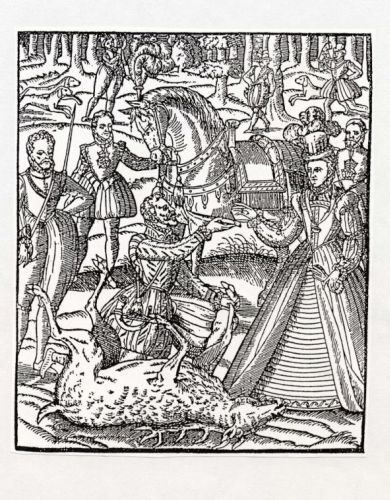
Figure 3. “... the Englishe manner, in breaking up of the deare”, in The Noble Arte of Venerie or Hunting (1575); from the Clarendon Press reprint, Oxford, 1908. By permission of the British Library, 799.2*1949*, p. 133/sig.I3.
15. Finally, brief mention should be made of the single woodcut in the Booke of Faulconrie (used twice, under
slightly different captions, at sigs. F and G8v) which is also Gascoigne’s (see
Figure 4). This illustration would have been commissioned by Christopher Barker
to complement those in the Noble Arte
and to enhance the appeal of Turberville’s book to Elizabeth’s courtiers. It features Elizabeth
, this time on
horseback and ─ aptly for its subject ─ much of the pictorial space
is given to the skies, just as the hunting scenes are filled with trees and
woodland. The woodcut shows the killing of the heron, a chase Turberville
describes as “a game of state” and “a noble sport to vew”. There are
identifiable stylistic similarities between the falconry and the hunting
woodcuts: the two sets of hatching on the horse’s neck in the “breaking up of
the deare” match those on the horse’s neck in the falconry woodcut, and the
face of one attendant on the right edge in both of these is very similar.
Furthermore, the distinctive profile of the chief huntsman, who appears in all
three hunting woodcuts, is very similar to the falconer in the left foreground
of the woodcut in the Booke of Faulconrie.
This seems to be an additional gambit, submerged in Turberville’s book, in which
Gascoigne creates a covert self-presentation as a falconer as well as a
woodman.
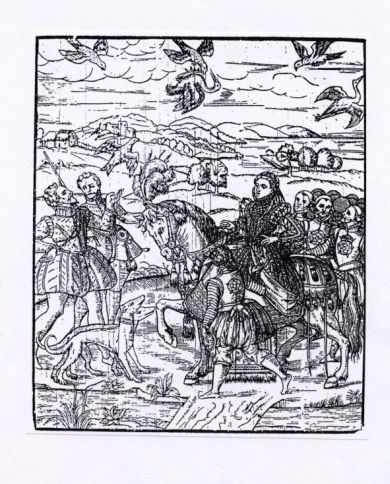
Figure 4. “How to slee the Hearon”, from George Turberville’s Booke of Faulconrie (1575). By permission of the British Library, G.2372.(1), page 112.
16.
Although
it is impossible at this remove to prove conclusively a link between Barker’s
combined project and rumours about the
Kenilworth
entertainments, the timing of these publications was at the very least
fortuitous. And, as I have suggested, the addition of the woodcuts showing
Elizabeth
enjoying both sports strongly
suggests that Elizabeth and her courtiers were the intended readers and
purchasers of both books. But it seems that Gascoigne’s involvement in the
events at
Kenilworth
may have been quite
marginal initially: his advance commission was only to write a device for
presentation in the woods, the masque of Zabeta,
which does not participate in the main Arthurian imagery. Nonetheless,
Gascoigne made the most of his opportunity and during the entertainments
Leicester commissioned two further devices at very short notice, one to explain
the first day’s devices and one to mollify
Elizabeth
upon her early departure (18).
Significantly, Gascoigne presented both of them in the Chase as the
Queen either rode out to hunt or returned from hunting. It is entirely possible that
Leicester came to hear of Gascoigne as the translator of the Noble Arte and commissioned a last-minute
additional device to be presented in the woods during one of the many hunts
planned; and then found that Gascoigne was extremely useful as an improvisattore and used him twice more,
locating him on both occasions in the Chase.
II
17.
Just six months after the anonymous publication of the Noble Arte, Gascoigne produced further
self-portraits in another work associated with his courtly ambitions. The
manuscript work Hemetes the Heremyte,
presented by Gascoigne to Elizabeth as a New Year gift (1 January 1576) is
closely associated with the entertainments at Woodstock during the same Summer
Progress, just a few weeks after the entertainments at Kenilworth. Another
woodland character, the hermit could well have been performed by Gascoigne, as
both Pollard and
Rosenberg
suggest (19).
The
Woodstock
events were hosted by Sir
Henry Lee, the Queen’s Champion, who was responsible for significant
developments in
Elizabeth
’s
iconography at this time because of his creation of the Accession Day tilts at
court. Lee was himself one of
Leicester
’s
faction and he is the most likely author of the English original of the tale of Hemetes, as Yates suggests (20). Gascoigne says
explicitly that he is not the author of the English tale but he offers it
translated into Latin, French and
Italian. The tale itself was highly topical and dense with coded
lobbying, of which the Queen was entirely aware: in an edition published in 1585
by Cadman she is noted (by an anonymous narrator) as requesting a written
version of it to read later (21). By the New Year, of course, such topicality
was lost, and so what Gascoigne presented in his witty, elaborate manuscript is
actually a standard humanist exercise of a set of translations, demonstrating
his facility with languages. But the most significant aspect of the Hemetes manuscript is not the hermit’s
tale, but the original material Gascoigne adds: the illustrations and the
textual framework create an artefact which situates itself at the highest level of courtly culture.
18.
The manuscript is clearly structured by its framing devices: the
frontispiece (Figure 5), with a prefatory sonnet and preface in English; the
English original of the tale; and then an emblem with a Latin motto (Figure 6)
and the Latin translation, aptly copied in an italic script; an emblem with an
Italian motto (Figure 7) to complement the Italian translation, copied in an
Italian hand; and an emblem with a French motto (Figure 8), complete with
the French translation in a French hand (22).
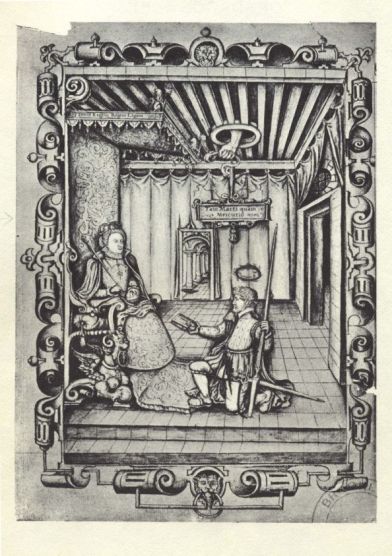
Figure 5. “Petrarks heire”: the frontispiece portrait in The Tale of Hemetes the Heremyte (1 January 1576). By permission of the British Library, MS Royal 18.A.xlviii, frontispiece.
19.
The Hemetes frontispiece
is a form of impresa-portrait, since it includes so many symbolic devices and
was done for a particular occasion, but it is also notable as being another
self-portrait (23).
It offers a courtly interpretation of his motto, “Tam Marti, quam
Mercurio” (“[Dedicated] as much to Mars as to Mercury”), complete with
symbolically divided costume: clad half as soldier, half as poet, Gascoigne
presents himself as the paradoxical “poett with a Spear” (a tilting-staff), the
most courtly manifestation of the soldier-poet. The disembodied hand which
suspends his motto from the ceiling suggests a divine presence and this, with
the laurel garland, reflects his apparent confidence. The epigraph to the
manuscript confirms the meaning of the floating laurel garland:
Yf god wolde deigne to make, a Petrarks heire of me
the coomlyest Queene that ever was, my Lawra nedes must be (24).
The impresa-portrait forms a bid for laureation further to the claims
Gascoigne had made at
Kenilworth only five
months before. Here, he was bidding for a role which would have a pension or
wage attached, or for a lucrative patent, such as the one accorded to Sir
Edward Dyer following his performance of the “Song of the Oak” at Woodstock,
which marked Dyer’s return to royal favour
(25).
The sonnet attached to the impresa-portrait
describes Gascoigne’s agenda most fully, proposing a comical confusion of the
two roles implied in his motto:
Beholde (good Quene) A
poett with a Speare
(straundge sightes well
markt are understode the better)
A Soldyer armde, with
pensyle in his eare
with penn to fighte, and
sworde to wryte a letter.
his gowne haulffe of, his
blade not fully bownde
In dowbtfull doompes,
whiche waye were best to take
with humble harte, and
knees that kysse the grownnde
presenntes hymselffe, to
yo[u] for dewtyes sake
And thus he saith, no daunger (I protest)
shall ever lett this loyall
harte I beare
to serve yo[u] so as maye
become me beste
In feilde, in Towne, in
Cowrte, or any where./
Then peereles prince, employe this willinge man
In your affayres to do the beste he cann./(26)
The poetic aspiration evident in the impresa-portrait is not sustained
in the sonnet, which wittily bids for any form of employment or preferment. But
this is an authentically petrarchan pose and entirely suited to his motto, since
the laurel garland could recognise both poetic and military excellence, and so
could reward either aspect of the soldier-poet’s skill.
20. Following the English original of the tale, Gascoigne offers his
Latin translation, copied in an appropriate hand (italic) and accompanied by an
emblematic device in Latin. The motto for the device is: “Spretaque sic vivunt,
sic conculcata resurgunt” (“Thus despiséd things live; thus things trodden
under foot rise again) (27). Snakes are
associated with Mercury (Gascoigne’s “Mercurio”) because of his caduceus, and
here, a snake is trampled down by a disembodied foot: the image seems to
suggest an external pressure being brought to bear on eloquence (see Figure 6).
Alluding to part of his personal motto, Gascoigne may be commenting on his own
struggle for recognition, and the failure of his early attempts to gain
preferment. In the symbolism of this emblem Gascoigne presents himself as the eloquent, downtrodden snake. But it is clear from the Latin motto that the eloquence is somehow
resurgent.
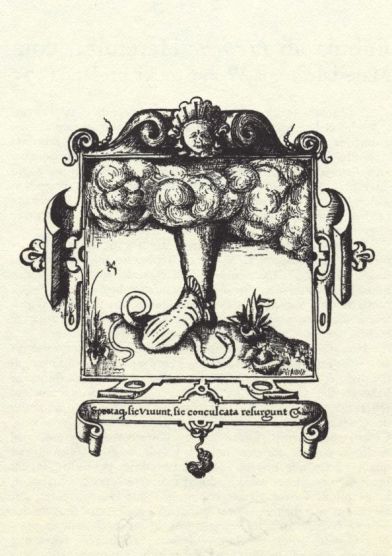
Figure 6. The Hemetes manuscript: Latin device. By permission of the British Library, MS Royal 18.A.xlviii, Latin emblem.
21. Following the Latin translation is the Italian translation, copied
out in an Italianate hand and accompanied by an Italian emblem (see Figure 7).
The verse continues the autobiographical theme:Chi tropo abbracia niente spesso tiene
cosi se vede un huomo ingordo & vile
Contrario a me ma piu di volte aviene
per far mostrar un nuovo & strano stile
pia[n]gendo Io vo pe ’l molto ben bramare
che tiene’l tutto, & niente puo abbraciare./ (28)
(Whosoever
embraces too much often holds nothing,
Thus you can recognise a greedy man of little worth,
The opposite of me. But more frequently it happens that
In order to demonstrate a new and strange style,
Lamenting I go, because of my great desire
That encompasses all, and can hold on to nothing.) (29)
The man in this emblem is once again identifiable from his curly hair
and big limbs as Gascoigne. “Chi tropo abbracia” suggests Gascoigne’s
over-reaching: the proverbial form is “Chi tropo tiene nulla stringe” (“He who
pretends to embrace too much often will have nothing”) (30) and, in his quest for rapid preferment in the 1560s, he
had clearly tried to grasp too much and ended up with very little. Gascoigne
had already used the proverb with regard to his quick-witted prodigals in the Glasse of Government (31). It must also be significant that the Baker’s
Boy, one of Gascoigne’s self-presentations in the Griefe of Joye, another presentation manuscript for Elizabeth, also gathers
faggots. Like this over-reacher, the Baker’s Boy has tried to gather so much
wood for his master that he ends up dropping it all. The motto recurs in
Whitney, A Choice of Emblemes (1586).
In the Hemetes manuscript, this “nuovo
& strano stile” could describe Gascoigne’s recent experiments in new genres
like the Prodigal Son play, new poetic forms like sonnet sequences and verlays,
courtly innovations like the Echo dialogue at Kenilworth,
or even his poetic theorising in “Certayne Notes of Instruction”. Among his
experiments this year was the Steele Glas,
probably the first original blank verse in English: “un nuovo & strano
stile” indeed (32).
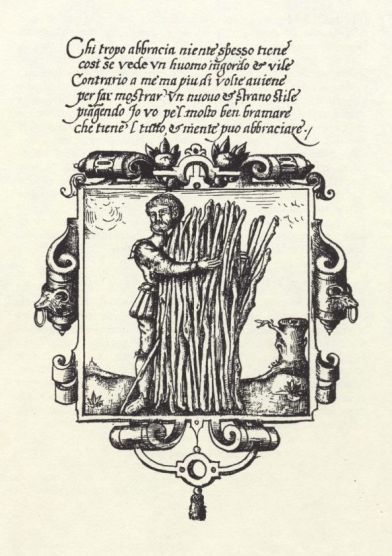
Figure 7. The Hemetes manuscript: Italian device. By permission of the British Library, MS Royal 18.A.xlviii, Italian emblem.
22.
Finally, following the Italian section is the French translation,
copied in a French hand and accompanied by an emblem with the motto in French
(see Figure 8) (33).
Two boys throw sticks at a walnut tree in order to knock off the nuts,
which is also proverbial:Noŭyërs sont (pour leur
fruits) battúz
des homes ingratz auxquelz ilz font profit
mais plus grand bien poursuyue leur merit
car plus fertilz ilz sont & revestúz
Moy malheureux: le mond s’ésbat dez miens
& suis steril (battú) mon fruict n’est
riens (34).
[Good walnut trees are beaten (for their fruits)
by ungrateful men to whom they are good value.
However, this perseverance is more profitable to
them [the trees],
As then they are more fertile and [verdure-]clad.
Unhappy me: the world frolics with mine
And I am sterile (beaten); my fruit is nothing.] (35)
This device is similarly concerned with both his literary endeavours
and his personal situation, but it is also the only emblem in the Hemetes manuscript for which it has so
far been possible to establish a definite source. Rosemary Freeman noted that
it is found in the Emblemata itself,
published originally in Latin and translated into Italian, Spanish, French and
German (36). It
may be one of the most ancient of emblematic images: Bath traces it to the Planudean Anthology (37). Ovid certainly knew of it, and wrote The Nux, the Lamentation of the Nut Tree,
based on the image of the walnut tree and its ill-treatment by the community.
The “nut-tree fable” was widely known in the humanistic tradition because of
Erasmus’s commentary on Ovid’s nut-tree, first published by Froben in 1524.
Gascoigne would certainly have known this text from his school days, and so he
did not simply copy the emblem: he added layers of meaning by its association
with the Ovidian nut-tree and its Erasmian commentary. In this image, it is the
tree which represents Gascoigne. The image is of one who has deserved well and
been ill-treated: the notion of “fruitfulness that does itself harm”
reformulates the suggestion in the Italian device that somehow his poetic
experiments have caused him difficulty. The precise topical detail cannot now be
recovered, but the device of the walnut tree clearly became, in Gascoigne’s
adaptation, the vehicle for what would have been a highly resonant
rhetorical-visual performance.
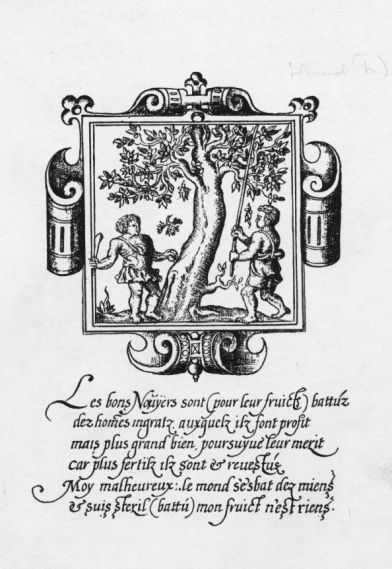
Figure 8. The Hemetes manuscript: French device. By permission of the British Library, MS Royal 18.A.xlviii, French emblem.
23. The non-textual narrative which emerges from Gascoigne’s sequence of
autobiographical emblematic devices is, then, first an elaborate and optimistic
performance of Gascoigne’s own motto, “Tam Marti quam Mercurio,” in its most
courtly manifestation, the “poett with a Spear”; followed by a device declaring
his downtrodden state and imminent revival (like the nut-tree, the snake is a
symbolic form of self-portrait); a representation of his struggles as a poetic
experimenter; and finally an image which resounds with disappointed hopes and a
sense of persecution. With the image of the nut-tree, Gascoigne hoped to arouse
pity for his condition, while highlighting his own creative fecundity. The
sequence amply demonstrates the range of distinct self-presentations Gascoigne
was able to present even within one work. As well as the overt demonstration of
draughtsmanship and linguistic skills, in the Hemetes manuscript Gascoigne
offers a highly developed facility with courtly, coded discourse. A royal
manuscript represents perhaps the most exclusive and highly focused of
patron-client relationships, but in
Elizabeth’s
court, her favour would make or break a career. Gascoigne was playing for very
high stakes indeed.
III
24.
In March 1576, just two months after he presented the manuscript of Hemetes to
Elizabeth
, Gascoigne published (anonymously)
his account of the Princely Pleasures at
Kenelwoorth. Both of these works are closely linked with his courtly
successes at Kenilworth and
Woodstock
the previous summer. But in April Gascoigne published under his own name The Steele Glas / The Complaynt of Phylomene,
another moralistic title (38). This volume had been at least a year in the
making and includes – in parts of the Complaynte
of Phylomene - his earliest dateable published verse.
It was dedicated to Arthur, Lord Grey of Wilton, who is considered Gascoigne’s
first and chief patron because he had already dedicated to Lord Grey his poems “Gascoignes wodmanship” and “Gascoignes
voyage into Holland, An. 1572” (both published in A Hundreth Sundrie Flowres, 1572/3) and “Dulce bellum inexpertis”
(published in the Posies) (39).
25.
There is ample evidence that the Steele
Glas volume had been long planned and - as well as the publication of the Princely Pleasures - it
coincides with Gascoigne’s involvement in the publication of Sir Humphrey
Gilbert’s A Discourse of a Discoverie for
a new passage to Cataia. Gilbert’s Discourse
was essentially a proposal (sponsored by the Earl of Leicester, among others)
addressed to potential investors in an expedition to try to discover the fabled
(and illusory) west-bound sea route to
China
. The prefatory epistle
Gascoigne contributed to that volume is dated April 12, 1576; only three days,
in fact, before the date of the dedicatory epistle to the Steele Glas (40). Alongside his recent courtly successes
Gascoigne had resumed work on his longer-term project to regain favour with
Lord Grey (and subsequently the Earl of Bedford, with the Droomme of Doomesday). But he remained an opportunist, willing to
undertake at short notice projects related to his courtly ambitions like the Princely Pleasures and Gilbert’s Discourse.
26.
In this way it is possible to see Gascoigne developing his portfolio
of moralistic titles concurrently with his courtly activities. However, it is
notable that because Gascoigne had known Lord Grey for several years, the Steele Glas/Complaynte of Phylomene is
characterised by his concern to overcome his poor personal reputation.
Gascoigne demonstrates his reformation by presenting himself as a penitent and
reformed prodigal, the same persona which had presented the Posies almost exactly a year before.
27.
Although it is a printed volume published under his own name, the
volume has the air of a presentation manuscript, since it addresses Lord Grey
repeatedly throughout. Tailored to his personal taste, it comprises two
narrative poems in medieval forms: one is a dream vision and one is an estates
satire, albeit in blank verse (and thus a radical experiment, the first
original poem in blank verse in English) (41). Its underlying theme of self-scrutiny is
evident in the controlling conceit of the satirical mirror in the Steele Glas, while the Complaynt of Phylomene, newly-cast as a dream-vision,
also participates in the notion of reflectiveness. Kathryn R. Lynch emphasises
the expectations raised by the genre, that it was “an appropriate mode for
poetic self-reflection” (42). It is this context which makes it certain
that the portrait of Gascoigne used as a frontispiece in the volume is in fact
a self-portrait (43). Some stylistic evidence also
supports this: the intense and slightly misaligned stare strongly suggests a self-portrait
drawn in a mirror (see Figure 9) (44). This was
Gascoigne’s first (and only) self-portrait in a named, printed volume and the
only self-portrait intended for wide dissemination. In this case a
self-portrait would form part of his founding conceit, what he would call his
“fine invention”.
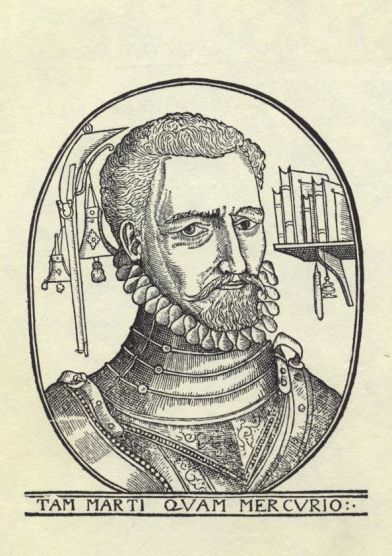
Figure 9. “Tam Marti quam Mercurio”: self-portrait from the frontispiece of Gascoigne’s The Steele Glas and Complaynte of Phylomene (1576). By permission of the British Library, Complete Works of George Gascoigne, ed. J.W. Cunliffe (Cambridge University Press, two vols., 1910), 12270.dd.12, vol. II, frontispiece.
28.
In context of his quest for preferment, it is easy to see that
Gascoigne’s self-portrait was calculated to demonstrate to Lord Grey his
commitment to self-scrutiny and, by inference, to self-improvement and
reformation. Such an image would have considerable tactical advantages if he
was trying to rehabilitate himself in the eyes of his old patron. The
self-portrait, above all, gives Gascoigne a prime opportunity for self-presentation. This is a mature Gascoigne; his eyes are
shadowed, his cheek is lined, and the contemplative set of his mouth is
complemented by the slight furrow between his eyebrows. This is a face which
could be seen as that of an older and wiser Gascoigne, who is now thoroughly
reformed and repentant.
29.
The image is subscribed “Tam Marti, quam Mercurio” and so it is also
another illustration of Gascoigne’s motto, an analogue to the impresa-portrait of the soldier-poet
in the Hemetes manuscript. The Steele Glas self-portrait can be divided
down the centre to reveal a martial side, with stern expression and weapons
hanging behind, and a courtly side with a shelf of books and an unlaced gorget,
reflecting the same division as in his symbolic clothing in the Hemetes frontispiece. It is notable that
in the Steele Glas self-portrait,
Gascoigne emphasises his possession of an arquebus - a weapon used by mercenaries in the
Low
Countries
- whereas
in the manuscript the weapon is a tilting staff, a chivalric weapon with no
practical use outside the court. The arquebus serves to remind his reader of
his recent experience in service of his country and his faith. That Lord Grey
had shown an interest in Gascoigne’s martial experience four years earlier is
evident in the “Voyage into
Holland
”,
so it is clear that Gascoigne was making an appeal to their past relationship.
The image of himself which Gascoigne disseminated in print was a pragmatic,
almost utilitarian version of the soldier-poet, “Tam Marti quam Mercurio”, less
than four months after his thoroughly courtly version of this self-presentation
in the Hemetes manuscript.
IV
30.
The following New Year, 1st January 1577, would prove to be the date
of Gascoigne’s last known literary works. He produced a set of illustrated
manuscript letters to potential patrons at court and another manuscript work
for Elizabeth, The Griefe of Joye.
That manuscript is not illustrated, but its relative plainness was crucial to
its underlying conceit, its “fine invention”. In October 1576, Gascoigne had
been sent to Paris and Antwerp as an observer for Lord Burghley, and he claims
that the manuscript of the Grief of Joye was actually the copy he had carried around with him during the siege of
Antwerp: “the leaves of this pau[m]phlett have passed with me in all my
perilles” (p. 514). That this was a
poetic flourish – a reminder of service with which Elizabeth had been
very well pleased – is evidenced by the clean and fair condition of the
manuscript as well as the gold leaf with which Elizabeth’s name is embellished
throughout. (Indeed, he had used the same device in Dulce Bellum Inexpertis, addressing Lord Grey, when he called it "this Pamphlette written by stelth at such time as we Loytered from service" [Pigman, p.399]). But it is a daring and witty flourish in an extremely witty work.
31.
By contrast, the presentation letters to potential patrons were
carefully illustrated, with what is likely to have been a set of
further emblematic self-portraits. The letter to his relative by marriage, Sir Nicholas
Bacon, Keeper of the Queen’s Seal, is the only extant example of these letters
(see Figure 10). It carries an illustration of “a man on horseback and a man
about to mount a barebacked colt”, in the words of the Manuscripts Commission (45). The letter
opens with an explicit agenda:
My verie favorable good Lorde,
beinge latelye receavede into Her Majesties service
(wherin I hope to recover my decayede estate) I devisede to presente all my
lordes and good frendes in Cowrte with certayne Emblems for their Newyeres gyftes, an exercyes (as I judge) neyther
unplesante nor unproffitable … (46).
These “lordes and good frendes in Cowrte” probably included literary
patrons with whom Gascoigne was already associated such as the Earl of
Leicester, the Earl of Bedford and Lord Grey of Wilton. But it almost certainly also included
several others, such as Leicester’s brother,
the Earl of Warwick, another high profile literary patron. Gascoigne had
already declared his intention to court Warwick’s
patronage in “Dulce bellum inexpertis”:
there, Warwick
appears in a procession of courtiers as “woorthie Warwyke he, / in whose good
grace I covet sore to be” (47). A set of emblematic letters such as Gascoigne
describes would have been an ideal opportunity to create self-presentations to
suit each of his potential patrons. Given the ample evidence throughout his
work of the care with which Gascoigne habitually selected his topic and
treatment, according to the tastes of his patrons and his relationships with
them, it is likely that he would have displayed his characteristic
inventiveness and developed a range of emblems and self-presentations to appeal
to each of his dedicatees.
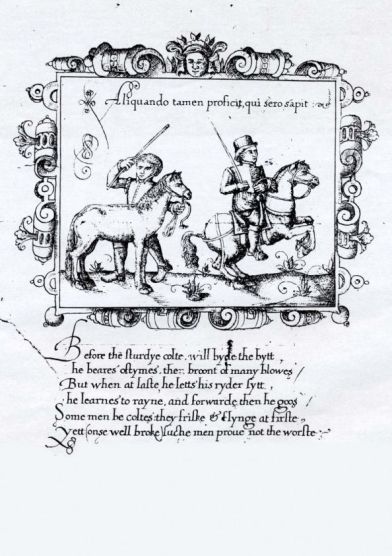
Figure 10. Reproduction of Gascoigne’s letter to Sir Nicholas Bacon, 1st January 1577 , from the original, held by Norwich Record Office, Ray. 25. By kind permission of Marquess Townshend.
32. The text confirms that this is indeed another emblematic
self-portrait. Above the illustration is the motto, “Aliquando tamen proficit
qui sero sapit” (He who becomes wise late in the day, eventually, nevertheless,
becomes serviceable) (48). The tamed colt was, then, another variant of
the Reformed Prodigal, rejecting the wildness of youth (49). So in this illustration it is both the colt and its rider, and the good horse and its rider, which actually
represent Gascoigne, showing his mastery of his “colltyshe and jadyshe tricks”.
The verse which accompanies the motto and illustration expands upon this
proverbial image of the unruly colt, from which “comes a good horse”: (50)
Before the sturdye colte will byde the bytt,
he beares oftymes the broont of many blowes
But when at laste he letts his ryder sytt,
he learnes to rayne, and forwarde then he goos
Some men be coltes: they friske & flynge at firste
Yett (onse well broke) suche men prove not the worst:
Gascoigne had been related to Bacon
by marriage since 1562 and, as with his book for Lord Grey, who also knew him
well, it is unequivocally penitent. The significance of his powerful relative’s
position at court is obvious. Gascoigne makes an urgent appeal
for help:
But (my good Lorde) my colltyshe and jadishe trickes
have longe sithens broughte me owte of fleashe, as withowte some spedye
provysione of good provender I shall never be able to endure a longe jorneye,
and therfore am enforcede to neye and braye unto your good Lordship and all
other which have the keye of Her Majesties storehowse, beseachinge righte
humblie that you will voutchsaffe to reamember me with some extreaordynarye
allowaunce when it fallethe.
Although he had been paid
£20 in November for his trip to Antwerp,
Gascoigne was always in debt and he had almost certainly had to depend on
credit to finance his trip. Despite the unmistakable royal favour evidenced by
both the Spoyle of Antwerpe and the Grief of Joye, he had not yet received
more tangible rewards. The presentation manuscript and the set of emblematic
letters form a co-ordinated strategy to build on his favour at court this New
Year, but nothing else is known of George Gascoigne until his death on 7
October at Stamford in Lincolnshire, as recorded by George Whetstone
(51).
33.
The contrasting self-presentations in the Grief of Joye and the letter to Bacon give final proof that
Gascoigne cultivated a number of identities simultaneously, for they belong to
the same date and occasion. Each identity is designed with the dedicatee in
mind. This entirely pragmatic approach to poetic identity allowed him to be
both “Bartholmew” to
Elizabeth
and the now-tamed unruly colt to his powerful relative, Sir Nicholas Bacon, for
the presentation of New Year gifts at court on 1st January 1577.
34.
The two years during which Gascoigne produced his extant
self-portraits were his most successful period. He was in great favour at
court, with Elizabeth herself and with some of the most powerful members of her
court: there is clear evidence of links with the Earl of Leicester, Sir Henry
Lee, Lord Burghley and Sir Francis Walsingham, as well as Gascoigne’s earlier
patrons, Lord Grey of Wilton and the Earl of Bedford. Gascoigne’s many
self-presentations were devised to allow him to position himself favourably in
relation to various patrons. His approach is purposeful and opportunistic. The
moralistic self-presentation, the Reformed Prodigal, attempts to overcome his
poor personal reputation. And the courtly self-presentations display skills
including woodmanship, languages (Latin,
French, Italian), draughtsmanship, improvisation and performance, wit, and a
remarkable facility with coded discourse. Each of Gascoigne’s illustrations
fulfils a pragmatic purpose and, considered together, they form a gallery of
self-portraits to complement his range of poetic personae.
Notes
1 Corbett and Lightbown note the continuity
from author-portraits in medieval presentation manuscripts to those included on the verso of the title page in
printed books: Margery Corbett and Ronald
Lightbown, The Comely Frontispiece. The
Emblematic Title Page in
England
1550-1600 (London: Routledge & Kegan Paul, 1979), p. 43.
2 Thomas Becon, Worckes (1560-4, 3 vols., fol.,
John Day
).
3 The scholarly Skelton features in works
like Why come ye nat to cowrte?
(?1565); it is traced by Edward Hodnett, English
Woodcuts 1480-1535 (London: Bibliographical Society at OUP, 1935), no.
2287. Hodnett traces a number of possible author-portraits including nos. 83,
142, 927.
4 Lisa Jardine, Erasmus, Man of Letters (Princeton University Press, 1993), esp.
pp. 45-53.
5 The authoritative edition is by G.W.
Pigman III, George Gascoigne, A Hundreth
Sundrie Flowres (OUP, 2000). It includes all the changes in the Posies and excellent commentary and
apparatus.
6 Charles T. Prouty, George Gascoigne: Elizabethan Courtier, Soldier and Poet (New York:
Columbia University Press, 1942). See also the introduction to my forthcoming
monograph.
7 Gillian Austen, George Gascoigne, Studies in Renaissance Literature, 24 (Cambridge: D.S. Brewer, 2008).
8 There are no modern editions of either
work except for the reprint Turbervile’s
Booke of Hunting. 1576 (Oxford: Clarendon Press, 1908).
9 Jean Robertson, “George Gascoigne and The Noble Arte of Venerie and [sic] Hunting,” Modern Language
Review 37 (1942): 484-5.
10 Charles and Ruth Prouty, “George
Gascoigne, The Noble Arte of Venerie,
and Queen Elizabeth at Kenilworth”, Joseph
Quincy
Adams
Memorial Studies (Washington:
Folger Shakespeare Library, 1948), pp.
639-664.
11 For a full account of the printing history
of du Fouilloux’s La Vénérie see
Charles and Ruth Prouty, ibid., p.
642 n.13.
12 Stephen Hamrick, ‘‘Set in portraiture’:
George Gascoigne, Queen Elizabeth, and Adapting the Royal Image’, EMLS 11.1 (May 2005), pp.1-30.
13 The phrase comes from his essay on English
versification, “Certayne Notes of Instruction”: “The first and most necessarie
poynt that ever I founde meete to be considered in making of a delectable poeme
is this, to grounde it upon some fine invention”, Pigman, ed. cit., p. 454.
14 For “Gascoignes wodmanship”, see Pigman, ed. cit., pp. 312-16; and for his
self-presentation in that poem see Jonathan Crewe, in Trials of Authorship. Anterior Forms and Poetic Reconstruction from Wyatt to Shakespeare (Berkeley: University of California Press, 1990), pp. 118-39. Daniel Javitch
also touches on this aspect of the poem in "The Impure Motives of
Elizabethan Poetry", Genre, 15
(1992), 225-38, pp. 231ff.
15 In any case, Gascoigne was in
Holland
on military
service between 1572/3 and 1574/5.
16 Sir Roy Strong considers the four
together, in Portraits of Elizabeth I
(Oxford: Clarendon Press, 1963), p. 122; and in The English Renaissance Miniature (London: Thames and Hudson, 1983)
he attributes them to Levina Teerlinc, a ‘book illustrator and portrait painter
in the royal service’, pp. 62-4.
17 Charles and Ruth Prouty, ibid., pp. 663-4.
18 Gillian Austen, “Gascoigne’s
Metamorphoses: The Princely Pleasures at
Kenilworth
,
1575”, in Imaginaires 4 (Revue du
Centre de Recherche sur l’Imaginaire dans les littératures de langue anglaise),
Presses Universitaires de Reims (1999), pp. 9-29.
19
See Eleanor Rosenberg, in Leicester,
Patron of Letters, p. 169n; A.F. Pollard, ed., The Queenes Majesties Entertainment at
Woodstock
1575 (Oxford: H.Daniel and
H.Hart, 1903/1910), p. xiii.
20 For Gascoigne’s denial in Hemetes, see Cunliffe, p. 477. This was
supported by Pollard, ibid., p. xvi; see
also J.W. Cunliffe, ‘The Queenes Majesties Entertainment at Woodstocke’, PMLA, 26 (1911), pp. 92-141, at pp. 127,
141; and Prouty, p. 223. Yates’s proposal is at p. 97.
21 The unique extant quarto of the Cadman
edition is incomplete, missing sig. A (the title page and three leaves) and
beginning in the middle of a sentence. A.F. Pollard acquired it for the
British
Museum
and published an edition, see
note 18. Cunliffe reprints the whole text in “The Queenes Majesties
Entertainment”, Proceedings of the Modern
Language Association 26 (1911), pp. 92-141.
22 See Gillian Austen, “Newyeres gyftes: Five
Emblematic Devices by George Gascoigne”, in Emblematica
14 (2005), pp. 101-126, for a more detailed version of this discussion.
23 Elizabeth Salter and Derek Pearsall,
115-116, list eight types of frontispiece author portrayal; Michael Bath, Speaking Pictures. English Emblem Books and
Renaissance Culture (London: Longman, 1994) pp. 10-11, discusses the
characteristics of impresa-portraits.
24 Cunliffe, Works,
vol. II, p. 510.
25 For Dyer’s patent, awarded this January,
see Ralph M. Sargent, At the Court of
Queen Elizabeth: The Life and Lyrics of Sir Edward Dyer (London: Oxford
University Press, 1935, rev. ed. 1968),pp. 33-35.
26 Cunliffe, Works, vol. II, p. 473.
27 My thanks to Professor Pigman for this
translation.
28 Cunliffe, Works, vol. II, p. 494.
29 My thanks to Dr Ben Thomas and Dr
Katia Pizzi for this translation.
30 My thanks to Dr Marco Dorigatti for
his comments.
31 The Glasse
of Government, IV v (Cunliffe, Works,
vol. II, p. 65).
32
Surrey
’s
influential Virgil (1540) was a translation and Sackville and Norton’s Gorboduc (1561) was a play.
33 Prouty argues that Gascoigne’s Latin is
legal and contemporary, not classical; his French is literal, learnt on
military service in
Holland
; and his Italian
literary, learnt in
London
,
ibid., p 227.
34 Cunliffe, Works, vol. II, p. 502.
35 My thanks to Dr Denis Renevey for this
translation and his comments.
36 Rosemary Freeman, English Emblem Books (London: Chatto and Windus, 1948), p. 52,
n.2).
37
Bath
,
ibid., p. 63.
38 For a modern edition, see William
L.Wallace, ed., George Gascoigne’s The
Steele Glas and the Complaynte of Phylomene: A Critical Edition with Notes (Salzburg: Institut für Englische Sprache und Literatur, University of
Salzburg, 1975).
39 Prouty discusses the friendship with Lord
Grey at pp. 56-7, 65, 91; and the Steele
Glas/Complaynt of Phylomene at pp. 241-63.
40 Cunliffe, Works, vol. II, p. 566.
41 Lord Grey was later associated with Edmund
Spenser, another medievalist.
42 Kathryn R.Lynch, The High Medieval Dream Vision: Poetry, Philosophy and Literary Form,
Stanford
,
California
,
1988, p. 71ff.
43 Gillian Austen,
“George Gascoigne and the Transformations of Phylomene”, in Elizabethan Literature and Transformation,
ed. Sabine Coelsch-Foisner (Tübingen: Stauffenberg, 1999), pp. 107-119.
44 Art historians have connected the rise of
the self-portrait in the sixteenth century with improvements in mirror
technology which increased the potential for spectacular mannerist effects.
See, for example, Parmigianino’s Self-Portrait
in a Convex Mirror (1523-4), which
takes self-scrutiny to a thoroughly introspective level. Alternatively, Wallace
suggests that “the satirist and his contemporary Maecenas, Lord Grey, are
looking into a steel glass together”, ed.cit.,
p. 42.
45 The letter was listed in the Historical
Manuscripts Commission’s report on the manuscripts in the possession of the
Marquess Townshend (1888) and now held in Norfolk Record Office. It was first
discussed by B.M. Ward in “George Gascoigne and his Circle”, RES 2 (1926), pp. 32-41.
46 The letter is reprinted (modernised) in
Ward, ibid., pp. 32-41; and with
original spelling in The Papers of
Nathaniel Bacon of Stiffkey, ed. A.H. Smith and G.M. Baker (Norwich, 1983),
pp. 3-4. Quotations are from Smith and Baker’s transcript.
47 ‘Dulce bellum inexpertis’ (196, 5), first
published in the Posies (1575). See
Pigman, ed. cit., p. 436.
48 My thanks to Professor Pigman for the
translation.
49 Other related proverbs emphasised the
unruliness of the colt: Tilley has, ‘There is no Colt but will break some
halter’ [C523] and ‘When you ride a young Colt see your saddle be well girt’
[C524].
50 Tilley has ‘Of a ragged Colt comes a good
horse’ [C522]. It was common from about 1450 onwards; see B.J. Whiting, Proverbs, Sentences … mainly before 1500
(Cambridge, Mass.: Belknap Press of Harvard University Press/ London: Oxford University
Press, 1968), C376, p. 94.
51 See Pigman, ed. cit., p. xli.
Bibliography
Austen, Gillian. George Gascoigne, Studies in Renaissance Literature, 24 (Cambridge: D.S. Brewer, 2008).
---- “Gascoigne’s
Metamorphoses: The Princely Pleasures at
Kenilworth
,
1575”, in Imaginaires 4 (Revue du
Centre de Recherche sur l’Imaginaire dans les littératures de langue anglaise),
Presses Universitaires de Reims (1999): 9-29.
---- “George Gascoigne and the Transformations of Phylomene”, in Elizabethan Literature and Transformation,
ed. Sabine Coelsch-Foisner, Tübingen: Stauffenberg, 1999: 107-119.
----
“Newyeres gyftes: Five Emblematic Devices by George Gascoigne.” Emblematica 14 (2005): 101-126.
Bath,
Michael. Speaking Pictures. English
Emblem Books and Renaissance Culture.
London
:
Longman, 1994.
Becon, Thomas. Worckes.
London
:
John Day
, 1560-4, 3 vols.
Corbett, Margery,
and Ronald Lightbown. The Comely
Frontispiece. The Emblematic Title Page in
England
1550-1600.
London
: Routledge & Kegan
Paul, 1979.
Crewe, Jonathan. Trials of Authorship. Anterior Forms and
Poetic Reconstruction from Wyatt to Shakespeare.
Berkeley
:
University
of
California
Press, 1990.
Cunliffe, J.W.,
ed. Complete Works of George Gascoigne,
vol. II.
Cambridge
:
Cambridge
University
Press, 1910.
Cunliffe, J.W.
“The Queenes Majesties Entertainment at Woodstocke.” PMLA, 26 (1911): 92-141.
Freeman,
Rosemary. English Emblem Books.
London
: Chatto and
Windus, 1948.
Hamrick, Stephen.
‘‘Set in portraiture’: George Gascoigne, Queen Elizabeth, and Adapting the
Royal Image.” EMLS 11.1 (May 2005):
1-30.
Hodnett, Edward. English Woodcuts 1480-1535.
London
: Bibliographical
Society at OUP, 1935.
Jardine, Lisa. Erasmus, Man of Letters.
Princeton
University
Press, 1993.
Javitch, Daniel.
"The Impure Motives of Elizabethan Poetry." Genre, 15 (1992): 225-38.
Lynch,
Kathryn R. The High Medieval Dream
Vision: Poetry, Philosophy and Literary Form.
Stanford
,
California
, 1988.
Pigman III, G.W. George Gascoigne, A Hundreth Sundrie Flowres.
Oxford: Clarendon Press,
2000.
Prouty, Charles T. George Gascoigne: Elizabethan Courtier, Soldier and Poet.
New York
:
Columbia
University
Press, 1942.
Robertson, Jean.
“George Gascoigne and The Noble Arte of
Venerie and [sic] Hunting.” Modern Language Review 37 (1942): 484-5.
Pollard, A.F. , ed. The
Queenes Majesties Entertainment at
Woodstock
1575.
Oxford
:
H.Daniel and H.Hart, 1903/1910.
Prouty, Charles
and Ruth. “George Gascoigne, The Noble
Arte of Venerie, and Queen Elizabeth at
Kenilworth
.”
Joseph Quincy
Adams
Memorial Studies (Washington: Folger Shakespeare Library, 1948), 639-664.
Rosenberg, Eleanor. Leicester,
Patron of Letters. New York: Columbia University Press, 1955.
Sargent,
Ralph M. At the Court of Queen Elizabeth:
The Life and Lyrics of Sir Edward Dyer.
London
:
Oxford
University
Press, 1935, rev. ed. 1968.
Smith,
A.H. and G.M. Baker, eds. The Papers of
Nathaniel Bacon of Stiffkey.
Norwich
,
1983.
Strong,
Sir Roy. Portraits of Elizabeth I.
Oxford: Clarendon Press, 1963.
----
The English Renaissance Miniature.
London
: Thames and
Hudson
,
1983.
Turbervile’s Booke of Hunting. 1576.
Oxford
: Clarendon Press,
1908.
Wallace,
William L., ed. George Gascoigne’s The
Steele Glas and the Complaynte of Phylomene: A Critical Edition with Notes.
Salzburg
: Institut für Englische Sprache und
Literatur,
University
of
Salzburg
, 1975.
Ward, B.M.
“George Gascoigne and his Circle.” RES 2 (1926): 32-41.
Whiting,
B.J. Proverbs, Sentences … mainly before
1500.
Cambridge
,
Mass.
:
Belknap Press of
Harvard
University
Press, London:
Oxford
University
Press, 1968.
Responses to this piece intended for the
Readers' Forum may be sent to the Editor at M.Steggle@shu.ac.uk.
 © 2008-, Matthew Steggle (Editor, EMLS).
© 2008-, Matthew Steggle (Editor, EMLS).
